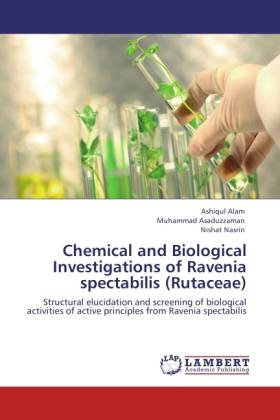
Je cadeautjes zeker op tijd in huis hebben voor de feestdagen? Kom langs in onze winkels en vind het perfecte geschenk!
- Afhalen na 1 uur in een winkel met voorraad
- Gratis thuislevering in België vanaf € 30
- Ruim aanbod met 7 miljoen producten
Je cadeautjes zeker op tijd in huis hebben voor de feestdagen? Kom langs in onze winkels en vind het perfecte geschenk!
- Afhalen na 1 uur in een winkel met voorraad
- Gratis thuislevering in België vanaf € 30
- Ruim aanbod met 7 miljoen producten
Zoeken
Chemical and Biological Investigations of Ravenia spectabilis (Rutaceae)
Structural elucidation and screening of biological activities of active principles from Ravenia spectabilis
Ashiqul Alam, Muhammad Asaduzzaman, Nishat Nasrin
Paperback | Engels
€ 67,45
+ 134 punten
Omschrijving
The work describes the chemical and biological investigations of Ravenia spectabilis of the family Rutaceae. Some works had been reported previously on this species, but the species grown in Bangladesh have not been studied extensively. Stem bark of the plant was extracted and the extract was fractionated by using standard chromatographic techniques. A total of four compounds were isolated. Isolated pure compounds were identified by their spectral data (1D and 2D NMR). Stem bark of Ravenia spectabilis yielded one alkaloid. The alkaloid has been characterized as arborinine [RS-1]. The other compounds isolated from the plant (RS-2, RS-3 & RS-5) could not be elucidated due to insufficient spectral data. Two VLC fractions of crude extracts from which pure compounds were isolated, were screened for their antibacterial activities against a wide range of both gram-positive and gram-negative bacteria by disc diffusion method. Antifungal activities against some clinically isolated fungi were also observed. The results obtained were compared with those for a standard antibiotic, kanamycin. The zones of inhibition produced by the VLC fraction-16 were found to be 08-12m.
Specificaties
Betrokkenen
- Auteur(s):
- Uitgeverij:
Inhoud
- Aantal bladzijden:
- 64
- Taal:
- Engels
Eigenschappen
- Productcode (EAN):
- 9783845476681
- Verschijningsdatum:
- 16/09/2011
- Uitvoering:
- Paperback
- Afmetingen:
- 152 mm x 229 mm
- Gewicht:
- 104 g

Alleen bij Standaard Boekhandel
+ 134 punten op je klantenkaart van Standaard Boekhandel
Beoordelingen
We publiceren alleen reviews die voldoen aan de voorwaarden voor reviews. Bekijk onze voorwaarden voor reviews.









